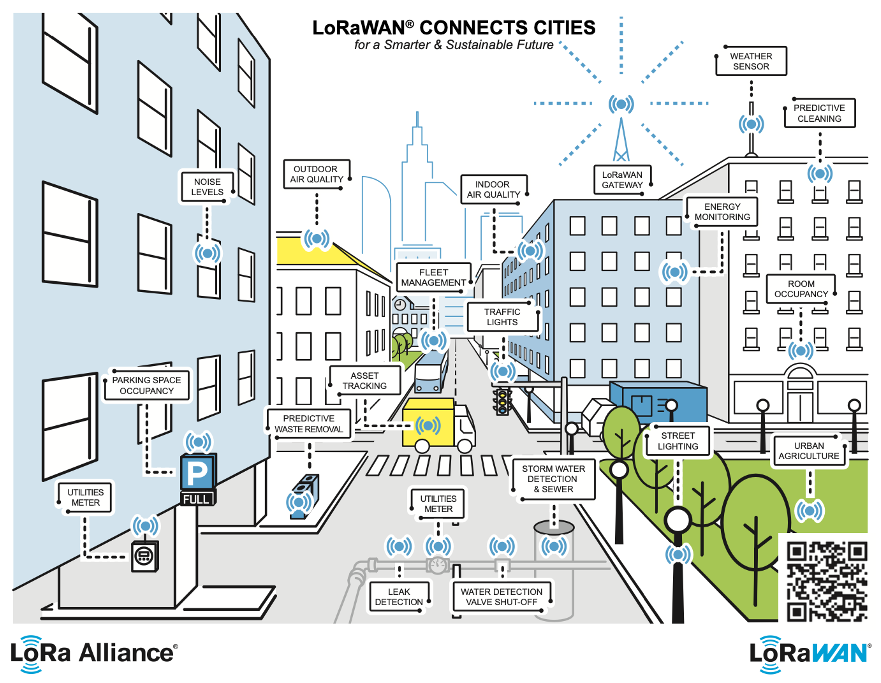
As local authorities face ever-increasing pressure to digitally transform public services to create cost efficiencies and meet citizen expectations, the need for a coordinated, smart approach to urban planning has never been greater.
In the latest Budget, the UK Government emphasised the urgency of this matter, proposing a new approach to public service reform centered around digital transformation.
One transformation area we are experiencing a growing shift in is IoT infrastructure to build smart cities, or ‘smarter places’, as we prefer to call them. From an economic perspective, sensor infrastructure is proven to boost productivity and, in turn, lower costs, but most importantly it holds the power to transform public services by improving insights and service quality.
Building smarter places through purposeful investment
With global investments in smart infrastructure on the rise, the demand for urban and rural areas to be both sustainable and efficient is reshaping the landscape of local government responsibilities. In 2023, research from GlobalData estimated that the smart infrastructure market was valued at $262.5 billion globally, and its rapid growth points to a significant opportunity for local and regional authorities to enhance public services through technology.
For local governments, smart infrastructure presents a pathway not just to optimise service delivery but to boost local economies by attracting investment, encouraging innovation, and improving productivity across sectors.
Despite the fact that governments recognise the role of sensors, the value of big data analysis and the application of connected devices as smarter infrastructure, reports from the UK Wireless Infrastructure Strategy and Ofcom fail to mention low power wide area networks (LPWAN) such as LoRaWan, a leading LPWAN technology for smart cities according to research from the LoRa Alliance and Beecham.
The UK Government instead sees the connectivity focus as Fibre To The Premises (FTTP) and the ubiquitous roll-out of 5G wireless infrastructure as the answer to all connectivity challenges.
However, the opportunity to deploy smarter infrastructure effectively, and most importantly efficiently, relies on widespread Low Power Wide Area Network (LPWAN) connectivity to connect the millions of sensors and deliver real value to government and public sector organisations. LPWAN has the power to revolutionise a wide range of industries at scale, pace, and for a fraction of the cost of higher cellular networks.
For example, an LPWAN network, LoRaWAN (Long Range Wide Area Network) is delivering accurate and timely water metering across millions of homes in the UK, it’s being used to detect damp and black mould in social housing, and it is an essential component in creating smart buildings of the future, tracking inventory, or efficiently managing energy consumption.

Data serves as the lifeblood of a smart city's success
Data lies at the core of every civic IoT deployment, driving its effectiveness and innovation. It enables real-time decision-making, enables efficient resource allocation, and allows for predictive measures that make cities safer and more efficient. However, data management remains a core challenge, particularly given the outdated and fragmented systems that many local governments still rely on.
Working with many public sector clients across the UK, it’s evident that the integration of data from legacy sources poses one of the most significant barriers to success.
Local authorities often juggle hundreds of separate applications and databases, each with their own structure and standards, creating silos that hinder comprehensive data analysis. Local authorities must prioritise investments in modern data management systems, with a strong emphasis on interoperability and platform integration.
This foundation will not only improve service efficiency but will create a collaborative ecosystem where public service teams and private sector service providers can leverage shared data to innovate and enhance civic outcomes.
How Hull became an IoT blueprint
Local governments can draw on the successes of pioneering cities like Hull in the UK, where digital transformation initiatives led by city officials have demonstrated real-world benefits.
We’ve worked with Hull City Council to support the deployment of LoRaWAN sensors to improve everything from energy efficiency to asset usage and gulley maintenance. The city’s digital platform, CityOS allows seamless data integration across an array of its core systems, through integration of many of the standalone software tools, allowing data from across the Council’s services to be managed in one place. This approach can be a blueprint for other cities, showing that investing in a city’s digital ecosystem can yield significant returns not only in cost savings but in public satisfaction and improved quality of life.
This approach can also be used by pan-regional bodies such as combined authorities to aggregate data across multiple towns and cities through a common management platform, empowering regional decision making and a more strategic approach. This can include databases that address health, transportation, and environmental goals, presenting a valuable opportunity for IoT infrastructure to help Combined Authorities manage complex data systems and meet essential targets including Net Zero.
The impact of AI on smart city developments
AI is set to have a transformative impact on many local government and public sector operations, but it will come into its own supporting smarter infrastructure through the management of IoT data. AI can process and analyse vast amounts of data from IoT devices, enabling the optimisation of urban services, predicting trends, and enhancing public safety. Driving city-wide automation, real-time decision-making, and personalised services across public services.
However, to maximise AI’s potential, data needs to better integrated as it grows in scale, processing needs to occur closer to the source, necessitating local and regional data centres to reduce latency. Currently, the UK faces some challenges in scaling data centre capacity to meet growing demand, particularly with the expansion of cloud computing and edge processing. Investment in energy-efficient data infrastructure will be key to supporting the future growth of AI-driven smart cities.
Moving forward: Collaboration is key
The potential of smart cities is vast, but its success hinges on local governments’ ability to collaborate, innovate, and commit to long-term investment in digital infrastructure.
Governments must foster long-term partnerships, that extend beyond city borders, working with regional and national bodies to develop scalable, interoperable solutions that support economic growth.
Hull’s success shows that smart city initiatives thrive in an environment of shared knowledge and resources. Additionally, through regional collaboration data can be leveraged to provide hugely valuable solutions, such as The Yorkshire & Humber Care Record creating interconnected regional systems, governments can leverage collective insights, avoid duplication, and drive service improvements across sectors.
The quiet revolution of smart infrastructure
Smarter infrastructure is already reshaping daily life in ways that most of us may not notice but undeniably benefit from – whether its improved energy management, reduced transit wait times, or predictive maintenance for essential city services. However, for smarter infrastructure initiatives to succeed, the path to becoming truly ‘smart’ requires a shift toward unified digital ecosystems where data flows freely and technology works seamlessly to support public needs.
The journey isn’t without its challenges, but as more places embrace these transformations, we’re witnessing the foundation of a more efficient, responsive, and resilient urban future. With sustained investment, strategic collaboration, and a commitment to data-driven innovation, local governments can transform the places we live into places that work smarter for everyone, setting the stage for a better quality of life and sustainable, meaningful benefits to communities for years to come.

Jason Legget
Jason Legget is Public Sector and Enterprise Solutions Lead at Connexin, revolutionising public sector and enterprise by deploying innovative LPWAN technologies with businesses, local authorities and the health sector.



